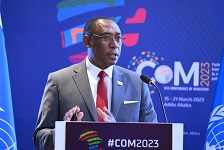Africa is set to miss most of the Sustainable Development Goals (SDGs) as a result of lack of investment in data and statstics, according to current research.
“If countries do not conduct censuses, this may affect the reporting on SDGs as more than 10 of the SDGs are informed by data from the census, said Oliver Chinganya, Director of the Africa Center for Statistics (ACS) of the Economic Commission for Africa.
“This will impact the decision making process. Similarly, when we talk about the AfCFTA, we want it to be a driver of the transformational agenda on the continent but to do that we must understand what each country is producing, for instance and what each country is tradingin, in terms of items, volumes and comparative advantages. For that you need data,” Oliver said.
“Data is public good, the new oil, the gold that Africa must invest in to support its development,” Mr. Oliver said on the sidelines of the 55th Session of the Committee of Experts meeting in Addis Ababa, Ethiopia.
he stated that countries can take action to accelerate sustainable development if they plan better and invest in effective data and statistical systems. The mission of the Africa Centre for Statistics is to enable national statistical systems in Africa to produce high quality statistics, data and geospatial information to inform sound and evidence decision-making in support of sustainable development, regional and national priorities.
“We need to invest in data and statistics to support Africa’s industrialization agenda,” said Mr. Chinganya. In an interview with the ECA Communication team, Mr.Chinganya gave more insights on the role of data and statistical systems in the development of Africa, particularly in the achievement of SDGs. Excerpts:
Data is the collection of information that is put into numbers, according to Oliver. “When you manipulate those numbers and create averages then they turn into statistics. Statistics are an aggregation of a collection of numbers. “For example, let’s say there are ten pupils in a school and the first pupil got 75% while the lowest got 42% in grades but we ask what the average.”
“The average of those numbers aggregated scores of pupils becomes the statistic. So, statistics are value-added data that can be interpreted for some use. If we say we want to move, say 66% average of an indicator to say 88%, you then start to plan to attain that number.”
“It means you will need more resources to get to that by getting more pupils with good grades and that means they will get better opportunities, including better jobs as a result. These positive increments in jobs, etc means the value in the economy also increases as their contribution to the GDP increases,” he said.
“There has been an improvement in the state of data and statistics across countries on the continent if we compare the situation over 20 years ago where data was poor and close to non-existent in cases. There is a lot more that can be done in making data available but overall, many countries are making good progress. We have a situation on the continent where some countries, for instance, have not even conducted the censuses in the 2020 Round. This is concerning because the 2020 round is coming to an end in 2024.. I do not think it will be possible to see these countries conducting censuses in one year.”
“If the countries do not conduct the censuses it will have an impact on the reporting of the SDGs and other development frameworks including the national development plans. A census is the count of all people residing within a territory. The purpose for that is to help countries plan for the people in that particular territory. Some countries have not prioritized this. To date, 21 countries in Africa have not conducted their censuses and most of them are unlikely to complete them before 2024.”
“You mentioned that for every dollar invested in data and statistical systems, there is a $32 return on investment, if data is so powerful, why then are African governments not investing data and statistics?”
“As statisticians we have a responsibility to give governments the evidence of what it actually means to put a dollar in data and statistics. For example, if a government wants to determine the levels of school enrollment rate, it first needs to know the number of children that are available by doing surveys and by assessing how many pupils they have. Once they are able to do that, they begin to make the necessary plans. If we can show that if you put $1 in data this is what it means in the long run in terms of return on investment, perhaps governments will begin to see the value of data and statistics and begin to invest.”
He indicated that it is very important to have data for the SDGs. “When you are able to have data for SDGs which are properly aligned with the National Development Plans, it allows you to be able to know what is going on in improving the lives of people and overall national development. For instance, SDG#1 on poverty. You need information about poverty and inequalities. On SDG4 on education, you need to know the quality of education, how many children are going to school and what is causing certain children not to go to school? You need data for that. It is important to be measuring these kinds of issues to be able to inform development planning. We see a gap in the alignment of SDGs to National Development Plans.”

